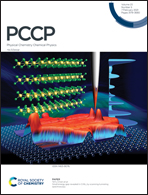Dynamic heterogeneity flow promotes binding reactions in a dense system of hard annular sector particles†
Abstract
We perform molecular dynamics simulations on a system of hard annular sector particles (ASPs) to investigate the reaction–dynamics relationship. The dimerization reaction zone, mixing reaction zone including dimerization and n-merization (n > 2), and arrested region are observed successively as area fraction ϕA increases from low to high. In this work, we focus on the properties of the concentrated arrested region (ϕA ≥ 0.400). The results show that for systems at ϕA ≥ 0.400, the ratio of n-merization increases with ϕA and n-merization finally becomes the dominant reaction in the system; dynamic heterogeneity (DH) is observed and is demonstrated to originate from the divergent size of clusters consisting of high-mobility particles; the particles with a high translational or rotational mobility are found to have a high ability to react with other particles at ϕA > 0.400; more interestingly, binding reactions are found to correlate spatially with DH at ϕA > 0.400. Our work sheds new light on understanding the role of DH in binding reactions or specific-site recognition assembly in a crowded environment.



 Please wait while we load your content...
Please wait while we load your content...